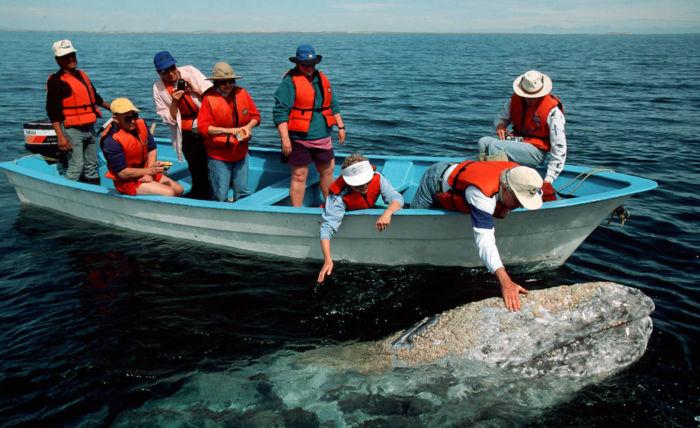There are countless magical creatures in the vast Pacific Ocean, and one of them inhabits both sides of the Pacific Ocean at the same time, which means that if you draw a semi-arc from the east Pacific coast to the west Pacific coast, it can basically be seen in this half-arc zone. This creature is also well known for its small black or white bumps that are highly susceptible to discomfort in patients with dense phobias. It is the Pacific shellfisher, the gray whale.

Image credit: The Photo Ark
The grey whale is the only remaining species of whale in the genus Grey whale in the family Gray Whale family. It is between 10-15 meters long and weighs about 30 tons, up to 36 tons. The fish is stout and has a thin head and tail, resembling a spindle. Its eyes are rounded, located above the mouth, closer to the top of the head than other baleen whales. Another difference from other baleen whales is that gray whales have only 2-4 longitudinal grooves in their abdomen and no fold grooves. This is because it is the most primitive of the baleen whales, and the folds are not yet developed. Gray whales have a darker body color in their juvenile years, mainly black and gray, and after adulthood, their body color gradually becomes mainly brown gray and light gray, which is also the origin of the name "gray whale". However, the most famous appearance of gray whales is the densely packed small pimples. In fact, these small knots are not found in its infancy, due to long-term migration and foraging on the seabed, the scars scratched by the rocks on the seabed over menstruation, and the attachment of some sea parasites such as barnacles to the body.
Gray whale head
Grey whale barnacles
The food of gray whales is mainly some crustacean creatures in the sea such as shrimp, crabs, shells and sea urchins, starfish, seaweed and so on. It is a baleen whale, or toothless whale, with only a long baleen in its mouth. Therefore, when foraging, the gray whale will directly dive into the seabed, use the mouth as a sieve directly, and swallow the creatures lurking in the sand on the seabed together with the sand and seawater into the stomach, which is very convenient.
Image source network
Gray whales generally mate in January and February of each year, and females gestate about 12 months and give birth to one litter per litter. Usually in January and February of the following year, females give birth to juvenile whales in the shallow sea area of the breeding area, and gray whales are the only baleen whales that will give birth in the shallow sea area. Baby whale babies are 4-5 meters long when they are born.
Gray whales are also the longest-migrating mammals on Earth. The annual migration distance is 10,000-22,000 km. Gray whales living in the eastern Pacific Ocean migrate from the Bering Strait and the Chukotka Sea all the way to breeding areas near the Baja California Peninsula in North America around May. Its counterparts living in the western Pacific Ocean migrate from the Sea of Okhotsk to the waters of our country's South China Sea. Their large-scale, long-distance migration has also spawned whale watching tourism along the route.
Migration map of gray whale distribution
As one of the largest mammal whales on Earth, although it is not as good as the big brother blue whale, the main natural enemy of the adult gray whale in nature is only the killer whale. But it's still the old question, that humans are the natural enemies of all living things on Earth. Before being protected by human legislation in 1946, gray whales were almost completely killed by humans. In addition to the two populations in the eastern and western Pacific Oceans, the gray whale had a population in the North Atlantic, which was hunted to extinction by humans in the 17th century.
As conservation efforts have increased, grey whale populations have continued to rise, and by 2004, populations in the eastern Pacific had recovered to about 30,000, while populations in the western Pacific had recovered very slowly, about 200 or so, and the current figure has stabilized. I hope that in the future, I can still see the figure of these creatures in the blue sea.